SciPEP 2023 Part 2: Perceptions and Preferences, Identity and Inspiration
SciCommBites X SciPEP collaboration: This SciCommBites summary is the second in our coverage of the 2-day SciPEP conference, focusing on Day 1.
This summary is longer than our traditional bites. Each presentation and panel is its own bite, woven together into a larger narrative. To help navigate the presentations, and panels in this summary, we are including a table of contents:
Perceptions and Preferences: What does (the) public want?
- What drives public support for (basic) science?
- Motivations for and barriers to engaging with science
- Does (basic) scientific language matter?
Identity and Inspiration: What do we know about “basic” scientists?
- Process-minded versus payoff-minded views of science
- What parts of a (basic) scientist’s identity matter the most?
- Science communication views of (basic) scientists at R1 universities
- Science communication views of (basic) scientists at AAU-affiliated universities
- Science communication views of (basic) scientists from a census of research publication authors
TL;DR
SciPEP 2023 aimed to: 1) share new findings and ideas about advancing basic science communication, and 2) examine whether basic science and scientists require distinctive or unique communication strategies, tactics, or training. The first two main sessions of SciPEP focused on sharing recent data on:
1. What we know about public identities and views of basic science – such as the extent to which they value/support certain topics, the negative /positive associations that they make with certain terms, and their motivations and barriers to engage with science.
| We learned that: We can continue to use the term “basic science.” It does not appear to change the public’s generally positive view of science. Education and political affiliation influence public support for basic science. We need to explore ways to expand the base of support beyond highly educated, left-leaning audiences.We shouldn’t be jealous of applied science. When the right context is provided, some areas of basic science may be as – or even more – supported or valued than applied science. We should be asking more context-specific questions in public polls. Sparking wonder and increasing knowledge are the top public motivations to pursue science interests, and they often coexist. We should therefore assess whether the curiosity versus utility dichotomy is the correct framework for discussion about basic science communication. The public judges research based on the institutions where it is conducted. Developing strategic communications about basic science should thus take into account where scientists work. |
2. What we know about scientists’ identities and views in the context of basic science – such as their views on science communication, the role that their scientific disciplines and institutions play on their overall trustworthiness as seen by the public, and their prioritization of communication goals and audiences.
| We learned that: The public associates science with hope, which holds an emotional reward in the future (payoff-minded). However many basic scientists associate science with joy, which holds an emotional reward in the present (process-minded). The frameworks of “payoff-minded” and “process minded” may be useful to explore distinctions among scientists in the future.The “basic scientist” identity is important and appears to have a modest influence on a scientist’s perceptions of science communication (e.g., use of social media), priorities (e.g., goals and objectives), and self-assessment of their communication skills. But, we cannot ignore the fact that there are other identities (e.g., culture and race) and factors (e.g., experience, nature of research) that may be just as or more important.Basic scientists tend to prioritize many of the same science communication goals and audiences as applied scientists. Future discussions should address supporting all scientists to be more strategic. |
Introduction
Day 1 of SciPEP 2023 explored the extent to which basic science communication requires unique strategies and tactics that are different from those of applied science.
To provide context for SciCommBites readers, we will first define basic science (also called fundamental, curiosity-driven, or discovery science). The NSF defines basic science as: “systematic study directed toward greater knowledge or understanding of the fundamental aspects of phenomena and of observable facts without specific applications towards processes or products in mind.” This includes, for example, how electricity flows through plasmas (like lightning and the sun). Discussions at SciPEP 2023 also encompassed use-inspired basic science (e.g., how to use plasmas to create fusion energy) or science that is adjacent to applied research (e.g., gaining a deeper understanding of the nature of plasmas as a result of research on predicting lighting strikes).
The SciPEP leadership team opened the conference with the overarching goals of:
- Sharing new findings and ideas about advancing basic science communication since the 2021 conference, and
- Examining whether basic science and scientists require distinctive or unique communication strategies, tactics, or training.
A summary of the information covered in the opening session can be found in the Executive Summary of SciPEP 2023 (Part 1 of our SciPEP coverage).
In this post, we focus on the first two main sessions from Day 1, which explore new findings about how the public thinks and feels about basic science, and how basic scientists think and feel about science communication. The next post will cover the last main session of Day 1, which focused on the nascent topic of what it means for basic science to be “relevant” in science communication and public engagement.
Sessions on Day 1 included discussions from science communication scholars, program leaders, and practitioners from various institutions about the public, scientists, and the nature of basic science based on their research and experiences in the field.
Perceptions and Preferences: What does (the) public want?
This session was facilitated by the Special Assistant to the Director at the Department of Energy (DOE) Office of Science, Rick Borchelt, who opened the session with the premise that “everything starts with the audience.” We cannot build successful communications about basic science without understanding who the audiences are, what may attract them to topics of basic science, and how we can identify them and their interests.
The session included three presentations of survey and opinion research by Cary Funk (Pew Research Center), Eve Klein (Association of Science and Technology Centers, ASTC), and Chris Volpe (ScienceCounts) who focused on our current understanding of how different public audiences perceive and engage with basic science, and whether they distinguish basic from applied science. After the presentations, Ken Goldstein (Association of American Universities, AAU) joined the panelists to discuss the takeaways from the presentations and share some insights from AAU polling work.
What drives public support for (basic) science?
To begin, Cary Funk, the Director of Science and Society Research at Pew Research Center, stressed that insights on how to communicate about basic research can (and should) come from understanding public opinion about all sorts of science. This requires that surveys provide specific research contexts when measuring public perceptions of science (basic and applied) and asking open-ended questions to determine how the public makes judgments about the societal value or purpose of science. Funk highlighted that survey research generally finds strong public support for science, although applied science tends to be more supported than basic science (Figure 1a). Interestingly, the factors that correlate strongly with support for science – such as higher education and left-leaning political views – also correlate with public trust in scientists.
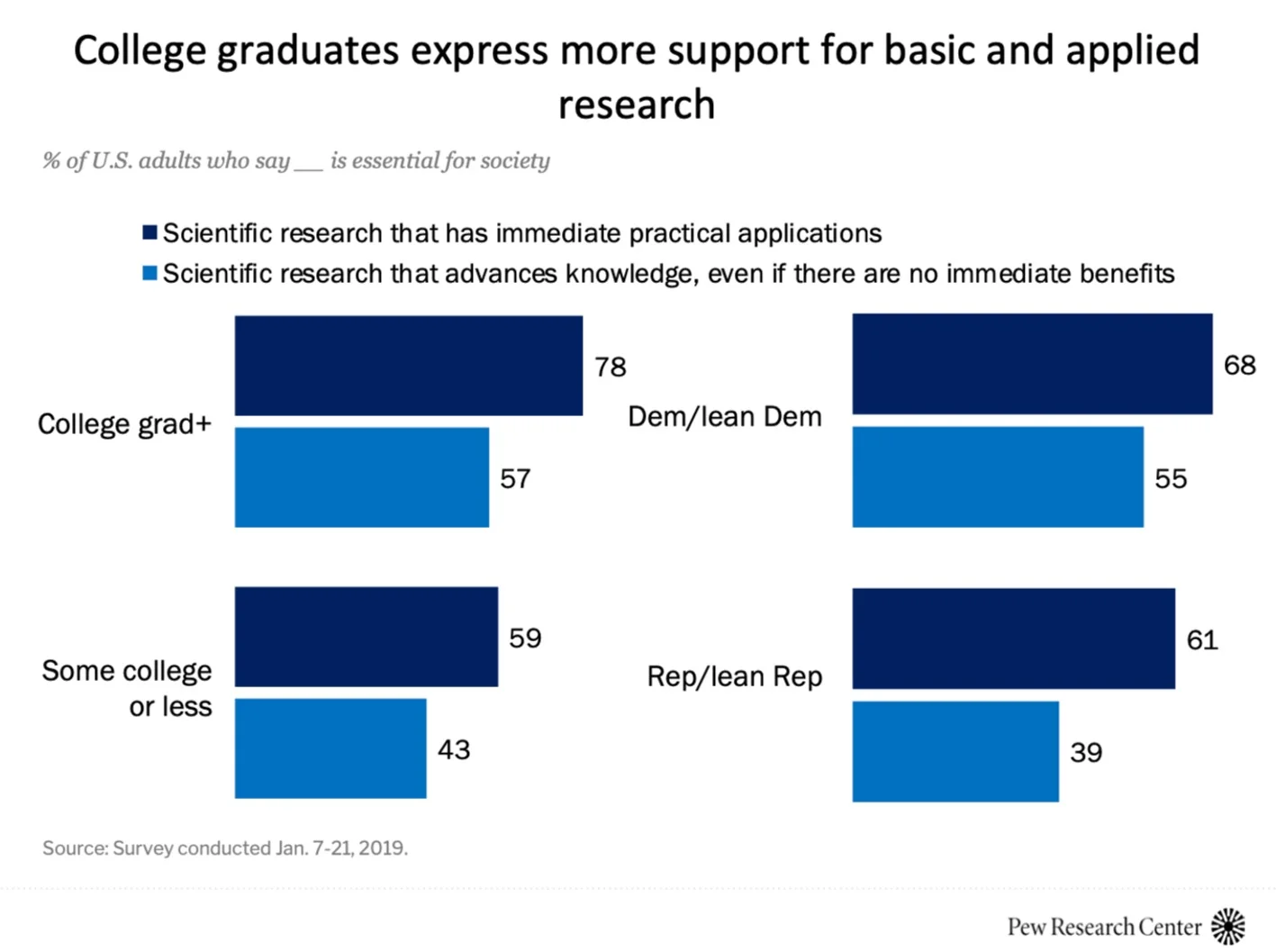
Yet, Funk and her team wanted to look beyond broad questions about science to explore how public support might change in specific research contexts. In a 2023 survey focusing on space science, they asked the public about the extent to which they support the prioritization of certain research topics by the National Aeronautics and Space Administration (NASA). They found that the public supports basic scientific research to increase knowledge of space: 40% ranked this topic as a top NASA priority, and 45% ranked it as important but not a top priority (Figure 1b). In fact, public support for basic research about space surpassed support for all but two of the specified applied research topics included in the survey (such as developing technologies that could be adapted for other uses, and searching for raw materials and natural resources to be used on Earth).
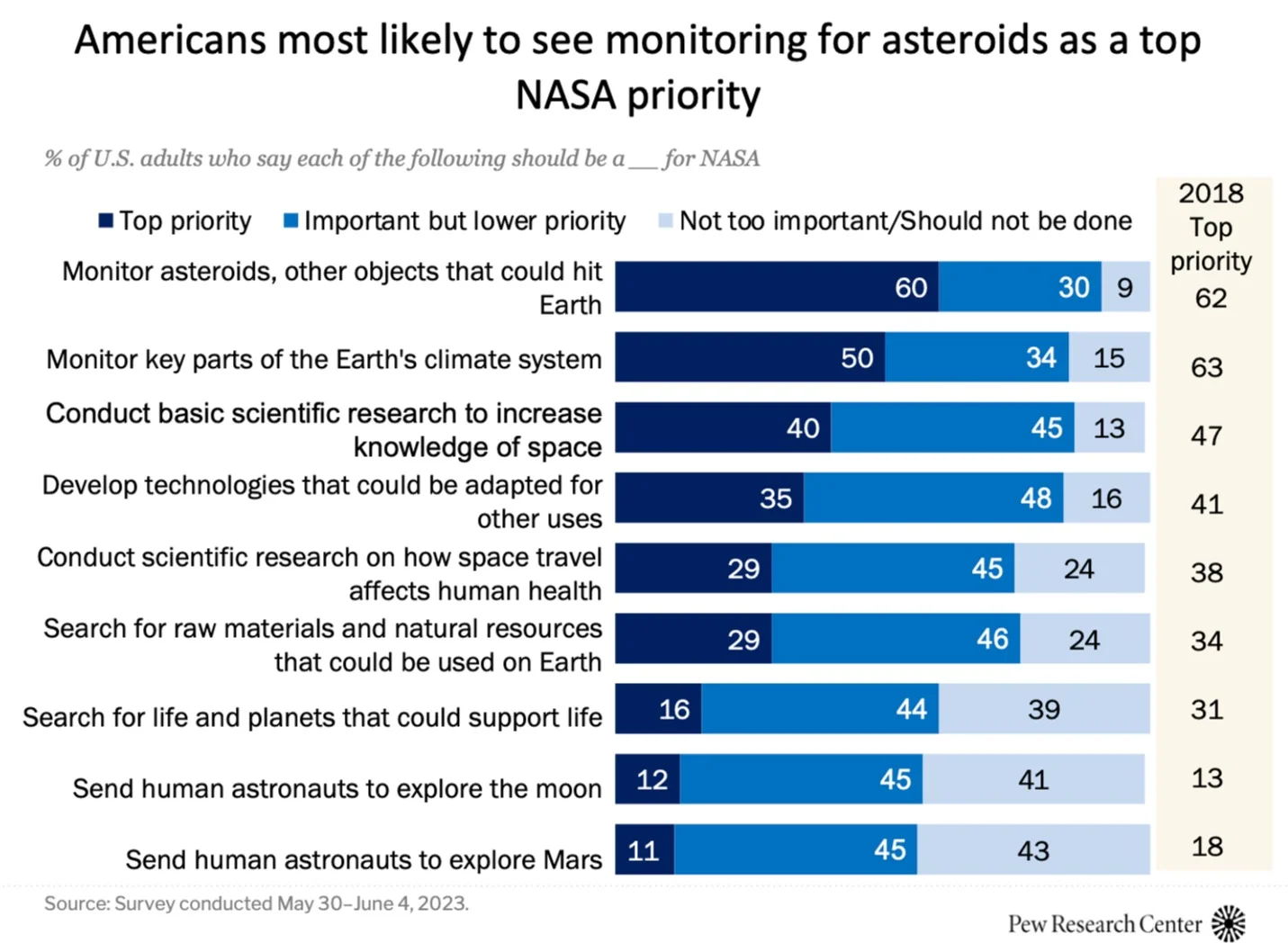
| The takeaways here are: The strongest correlates for support of basic and applied research are higher education and left-leaning political affiliation. So, what can we do to expand the base of support? How could science communication and science engagement be more relatable to people who have not experienced the ivory tower?People’s prioritization of basic and applied science research topics depends on the context in which they are presented. Even applied science is not guaranteed to have public support. So, how can public opinion polling on science provide more context/specificity? |
Motivations for and barriers to engaging with science
Second, Eve Klein, the Senior Advisor for Public Engagement with Science at ASTC, presented research on the motivations for and barriers to people’s interest in engaging with science. Klein’s team hoped that by investigating whether and how adults are engaging with science, they could provide science engagement practitioners with insights and data to develop more effective and inclusive science communication activities.
According to Klein and her team’s ongoing research, the top 5 (out of 20) possible motivations for pursuing science interests (Figure 2) are:
- to spark one’s imagination and sense of wonder;
- to gain new knowledge or skills;
- to bring joy or to feel good;
- to pursue something on one’s own; and
- to physically, mentally, or emotionally recharge.
Klein highlighted that three of these motivations (joy, pursuing on my own, and recharge) closely align with motivations for why Americans pursue hobbies. This suggests that science interests among the American public are akin to having hobbies (contrary to the belief that some science communicators may have that people’s interest in science is akin to pursuing a cause or connecting with an organization).
Klein and her team also examined whether and how race and ethnicity influence motivations for pursuing science interests. Although motivations did not differ significantly between White, Hispanic, and African-American groups, both Hispanic and African-American populations expressed a sixth motivation:
- preventing harm.
Reflecting on the top two motivations for public interest in science (imagination/wonder and knowledge/skills), Klein and colleagues noticed that this distinction is very similar to some of the discussions on possible distinctions between basic science communication and applied science communication. Those distinctions are primarily based on the assumption that basic science communication might need to tap more into the sense of curiosity or wonder, whereas applied science communication may need to appeal more to a sense of utility – applying knowledge or skill to a particular use.
So, Klein and colleagues analyzed whether those who were motivated by imagination and wonder were also motivated by gaining knowledge and skills. Their analysis showed that there is a stronger correlation between imagination/wonder and knowledge/skills motivations than any other pairings of the top five motivations for science interests. In other words, the same people are motivated by both imagination/wonder and knowledge/skills, which means that those motivations can in fact coexist and are not mutually exclusive. Thismay suggest that curiosity and utility should not be presented in science communication contexts as a dichotomy.
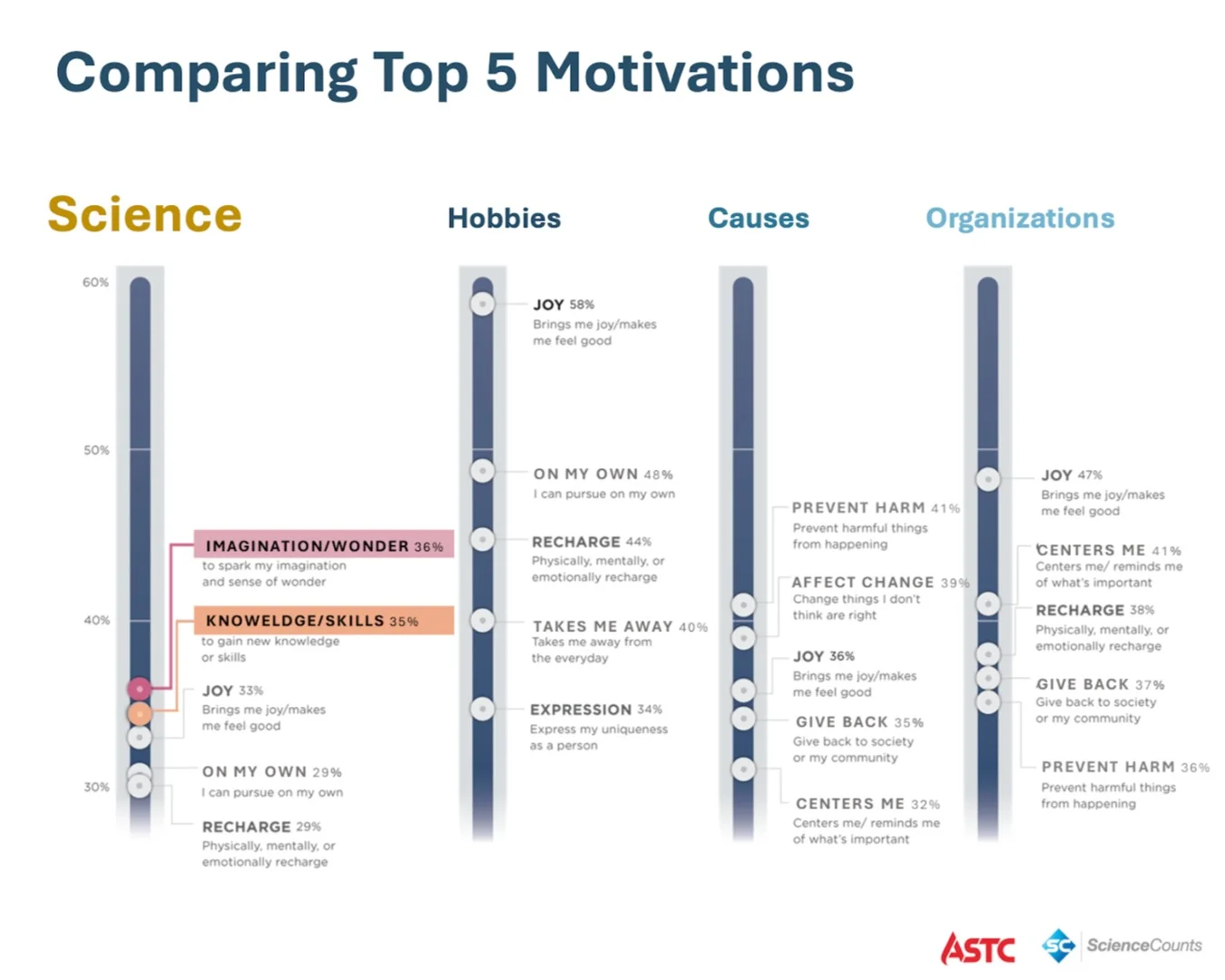
Klein and colleagues also cataloged four types of barriers – logistics, value proposition, belonging, and identity – that make it challenging for people to engage with science, even when they have an interest in science. Interestingly, while logistics barriers (such as not having enough time or nearby science engagement opportunities) mattered across all demographics, Hispanic and African-American adults were more likely than White adults to experience all four types of barriers identified by the research team, especially with barriers of belonging and identity. These findings indicate that efforts focused on improving a sense of belonging and identity could alleviate major barriers to science engagement for potential African-American and Hispanic publics.
| The takeaways here are: The top two motivations for the public to pursue science interests are to spark imagination/wonder and to gain knowledge/skills.The imagination/wonder and knowledge/skills motivations typically co-exist in people and are not mutually exclusive. This calls into question whether curiosity and utility should be linked in science communication efforts and not considered a dichotomy. Other top motivations include joy, the ability to pursue science interests on one’s own, and opportunities to recharge, all three of which align with the top reasons people pursue hobbies. Several barriers present challenges for the public to engage in science, even where there’s interest. Barriers related to identity and belonging are more likely to be found in Hispanic and African-American adults than in White adults. |
Does (basic) scientific language matter?
Chris Volpe, the Executive Director at ScienceCounts, focused his presentation on the language we use to talk about science and how it might impact public conversations about science. He shared relevant data drawn from eight different comprehensive national studies conducted between 2015 and 2022. The underlying assumption is that people may have negative associations with the word “science” based on bad past experiences and interactions with science, or they may associate negative connotations with descriptors such as “basic” to mean “not advanced” or “remedial.”
Volpe detailed findings corresponding to two main questions:
- Do we need to apologize for the word “science?”
- Do we need to apologize for the word “basic?”
Interestingly, when the research team asked the public about what comes to mind when they hear the phrases “scientific research” or “scientific discovery and advancement,” over half the participants responded with “nothing.” Volpe’s takeaway is that Americans have an unclear picture of the word “science.”
Looking broadly at words that the public associate with “science,” Volpe and his team found that the public negatively associates monetary and competitive terms with “science.” Yet, people positively associate terms such as “discovery,” “curiosity,” and “innovation,” with science (Figure 3a).
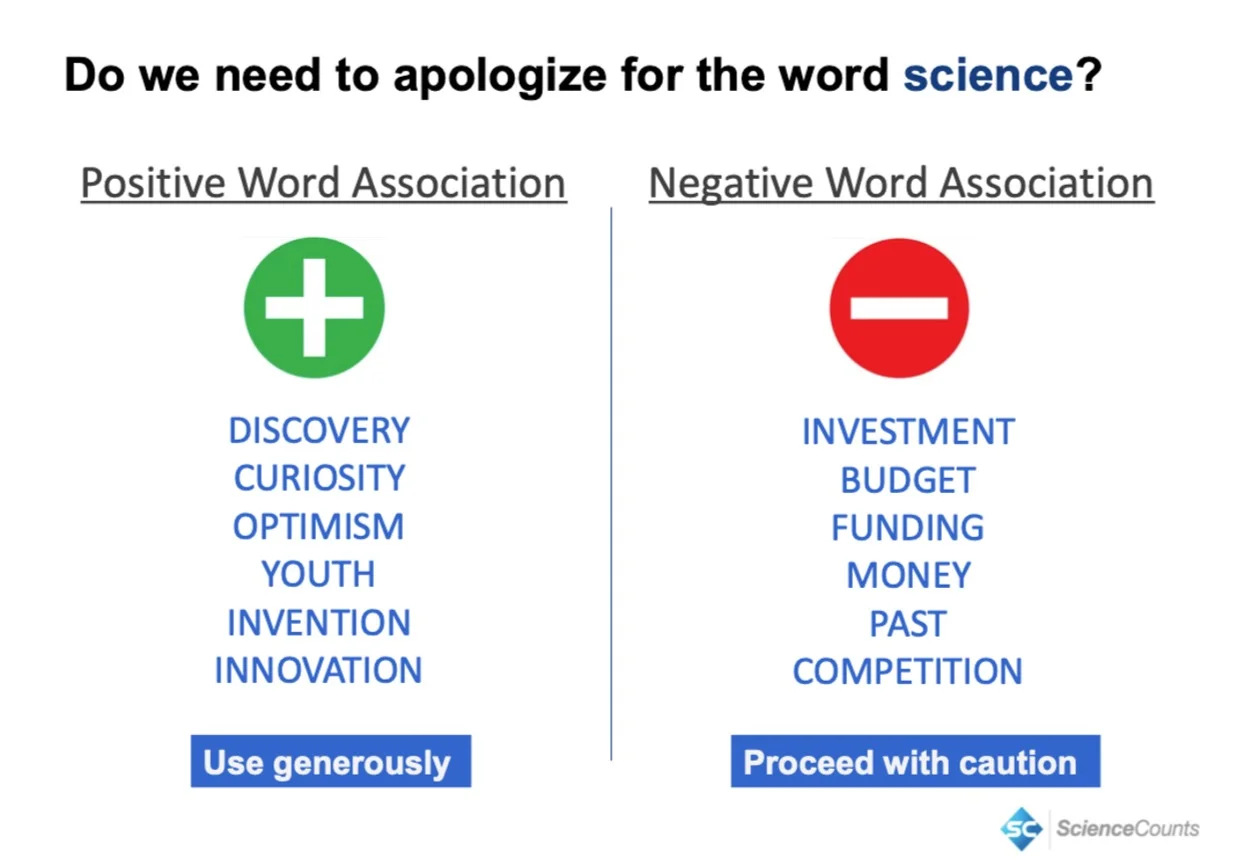
In addition, participants in the research focus groups talked about science as a “means to an end,” “a path to a better tomorrow,” and being in service to “the greater good.” Volpe concludes that Americans thus have a very utilitarian view of science, and, for a majority of Americans, science is associated with feelings of hope for a more positive future.
Volpe and his team also looked at perceptions of the words “basic” and “applied.” They found that the positive and negative associations with each label are statistically the same (~ ⅔ positive associations, ~⅓ neutral associations, and minimal negative associations) (Figure 3b). Volpe therefore suggested that Americans’ feelings towards scientific research do not change with the terms “basic” and “applied.”
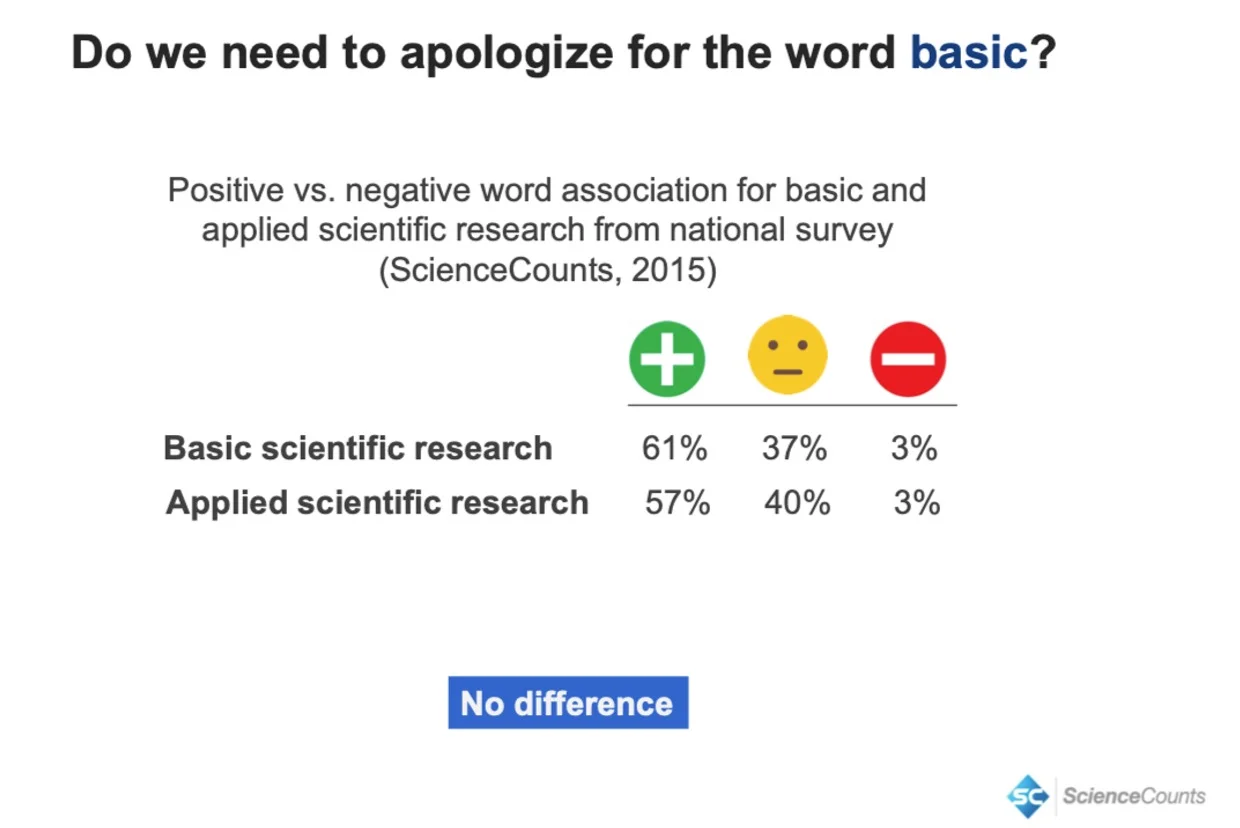
Another notable finding from Volpe’s team is that publics shape their perceptions of science based on where it happens. Science done at universities, for instance, is perceived by the public to be focused on discovering how things work, having no ideological agenda, being committed to solving specific problems, and fostering collaborations. Science done by the government, on the other hand, is perceived to benefit the public at large and the disadvantaged, while science done by the private sector is believed to drive economic growth and create new processes and products. Therefore, the place where scientists (the messengers) work has a role in how the public perceives them and their work. Understanding the assumptions that audiences may have towards scientists and their workplaces could potentially help us communicate about basic research more effectively.
| The takeaways here are: Americans have a vague view of the word “science.”Using words like “discovery” and “curiosity” when communicating scientific research brings positive feelings and perceptions, whereas making associations with competitive and financial language leads to negative feelings and perceptions. Americans associate science with hope. We should feel comfortable using the term “basic science.”We should consider perceptions of the messenger (e.g. where scientists work) when developing strategic communications about basic science. |
Reflecting on the three presentations, Ken Goldstein, the Senior Vice President for Survey Research and Institutional Policy at the AAU, referred to observations that public support for science has recently dipped, which warranted his question: “Why don’t Americans seem to care about science?” Goldstein linked this observation to recent public surveys showing that trust in institutions has hit new lows and that corresponding attitudes seem to correlate with certain political affiliations.
Yet, despite a decrease in confidence that the public may have toward science, Goldstein still observed a communication opportunity: although people may not express support for science, they also do not express opposition. People often do not know enough about those topics to support or oppose them, so neutral options should always be available in survey research to allow us to learn about the audience. Volpe similarly cautioned that in order to understand the relationship between science and the public, researchers need to acknowledge that publics have different roles at different times– such as consumers, participants, and critics. As a result, they tend to answer the same questions differently depending on what “role” they may be playing at the time of their response.
The panelists and discussants reflected further on how scientists can present their work in ways that resonate more with the audience, such as by acting in people’s best interests and finding common grounds. The panelists generally agreed that specificity about scientific topics and questions to make them more tangible (e.g., the space research topics listed in Funk’s survey above) and positive phrasing (e.g., innovation, curiosity) are effective techniques to communicate about basic science.
Identity and Inspiration: What do we know about “basic” scientists?
The second main session of Day 1, facilitated by Keegan Sawyer, Project Manager of Science of Science Communication at the U.S. The Department of Energy, Office of Science, looked at how basic scientists think and feel about science communication and public engagement. She emphasized the importance of understanding the identity of basic scientists and the implications of this identity on science communication, as well as what inspires or motivates scientists to develop clear communication goals.
Process-minded versus payoff-minded views of science
To provide context for this Session, Volpe shared results from a 2019 ScienceCounts public survey and a 2019 study by Besley, Dudo, and Newman on the differences and similarities between scientists and public feelings toward science.
When asked which words best describe how they feel about science, 43% of scientists say “joy” is the primary feeling they associate with their work, which was only shared by 13% of the public. “Hope,” on the other hand, is the primary feeling that 56% of the public associates with science, which was selected by only 37% of scientists. To visualize the responses, the ScienceCounts team plotted Joy (y-axis) vs. Hope (x-axis) and noticed a clear separation between the public’s and scientists’ feelings toward science (Figure 4a).
Volpe explained the emotional distinction between “joy” and “hope” as potentially due to a difference in ideological perceptions. As a feeling, “hope” holds an emotional reward for the future. Individuals who feel hopeful about science are thus focused on an eventual pay-off. “Joy,” on the other hand, grants an emotional return in the present and represents a more process-minded view.
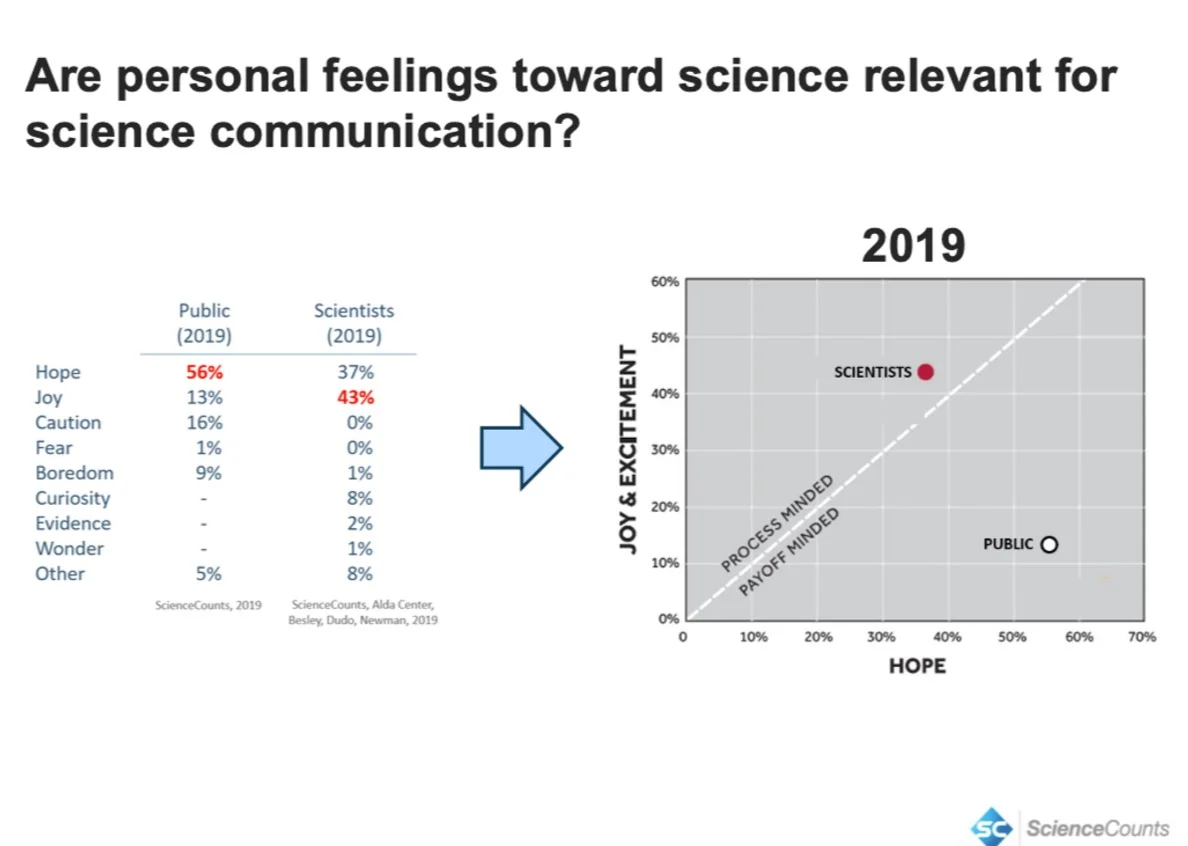
Because hope and joy were selected by scientists more than other feelings, Volpe’s team explored whether demographic factors may lead some scientists to be closer or further away from the public. First, the researchers explored whether political ideology, career level, or job sector influenced scientist results, but found no connections. Meaningful patterns emerged only when scientists were categorized by their scientific discipline (Figure 4b).
Scientists in disciplines associated with basic research (e.g., physics and geology) selected “joy” as the best descriptor for how they feel about science. Those scientists therefore clustered in the “process-minded” part of the diagram that is further away from the public clusters. On the other hand, scientists in disciplines that are more associated with applied science (e.g., social science and engineering) clustered closer to the public in the payoff-minded region of the diagram.
As a result, the ScienceCounts team decided to categorize scientists as either basic or applied based on their identified disciplines (Figure 4b) and found that basic scientists mostly fell in the process-minded region of the graph (focusing on the process of science – the how) and those doing applied research mostly fell in the payoff-minded region of the graph (focusing on potential outcomes from science – the what). Volpe and his team concluded that payoff-minded and process-minded may be a more useful distinction than basic and applied when it comes to examining scientists’ viewpoints or addressing their science communication needs.

| The takeaways here are:The public and applied scientists associate science with “hope,” which holds an emotional reward for the future– a payoff. Basic scientists are more likely to associate science with “joy,” which grants an emotional return in the present and represents a more process-minded view. |
What parts of a (basic) scientist’s identity matter the most?
Further navigating the science communication tools needed to support basic scientists, Olivia Ambrogio, the Assistant Director of the Sharing Science Program at the American Geophysical Union (AGU), shared her perspective as a science communication expert who provides support (such as training workshops on policy, media, social media, and storytelling) for scientists to communicate effectively and create dialogue with the public. AGU’s Sharing Science Program primarily works with scientists in basic science disciplines (e.g., biology, geosciences, and biochemistry) and, to a lesser extent, applied science disciplines (such as social sciences and engineering). Prior to a communication workshop, Ambrogio typically asks scientists about what they hope to learn about communicating science to broader audiences and what they are apprehensive of in terms of science communication.
From extensive training and discussions with scientists who attend the AGU workshops, Ambrogio has noticed that the basic science researchers “to some degree” are less familiar with information about the fundamentals of science communication and lack the skills to connect their work directly to values held by the public. She said the reason for this difference could be the way that basic scientists think about science, or that they may have less experience interacting on a regular basis with non-scientists – both could be reasons that affect their ability to communicate effectively.
However, Ambrogio urged conference attendees to consider that other aspects of identity could have greater influences on a scientist’s ability to grasp communication principles. Examples include scientists holding identities that are underrepresented in science or studying topics that do not relate to society and the public at large. Ambrogio therefore believes that the distinction between basic versus applied science identities is kind of important, but that it is dangerous to assume that basic versus applied science is the only or even the most important distinction influencing a scientist’s communication motivations, skills, and experiences. Ambrogio’s conclusion is that acknowledging a scientist’s identity and purpose is an important part of supporting a scientist’s communication and dialogue with the public.
| The takeaways here are:Basic vs. applied science distinction seems important, but other aspects of a scientist’s identity may have greater influences on a scientist’s communication skills, motivations, and experiences. Scientists’ identities must be considered when designing public engagement support for scientists. |
To put these ideas into perspective, the remainder of the session looked at survey data that examined two aims:
- what scientists aim to achieve by communicating about science, and
- whether there is anything unique about the identity and communication interests of basic scientists compared to applied scientists.
Science communication views of (basic) scientists at R1 universities
As part of a larger research study, Sara Yeo, Associate Professor at the Department of Communication and the Director of the STEM Ambassador Program (STEMAP) at the University of Utah, examined the perceptions of scientists at R1 universities on using social media to communicate science. The results she shared at the SciPEP conference focused on scientists’ views of:
- whether it is acceptable to use social media,
- the perceived effectiveness of social media in engaging audiences with science,
- the perceived effectiveness of social media in informing audiences about science, and
- their self-efficacy at communicating using social media.
Yeo and her team are one of the first 3 research groups (in addition to Todd Newman and John Besley’s groups) to ask scientists how they characterize their research in order to learn about the potential influences of research identity on their science communication (Figure 5a). Interestingly, “equal parts basic and applied” and “mostly basic” were the most selected options. For analysis, Yeo used the responses to categorize scientists as either mostly basic, equal parts basic and applied, or mostly applied (Figure 5a). They then assessed the correlation between this identity and the above measures. The team found that although there is no difference in scientists’ acceptance of using social media for science communication, those in the “mostly basic” group scored significantly lower than the other two groups (“equal basic and applied” and “mostly applied”) on their perceptions of the effectiveness of social media in communicating science (in terms of informing, engaging, and fostering trust with the public) and their perceived self-efficacy of using social media (Figure 5b).
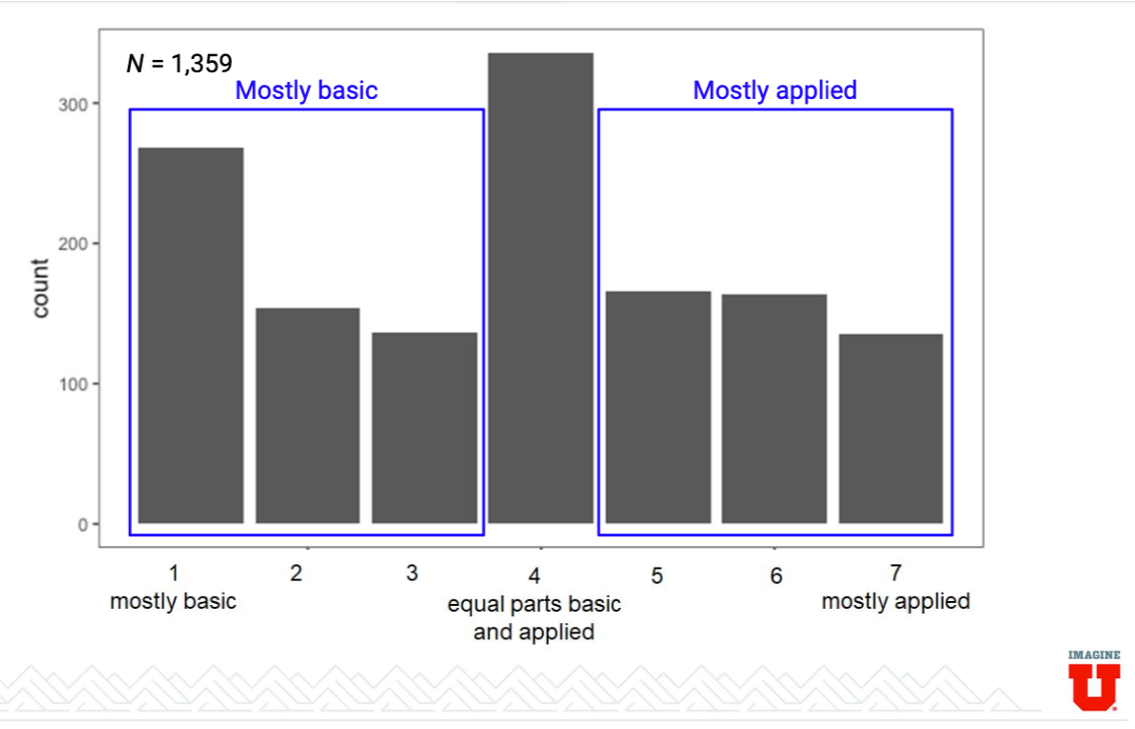
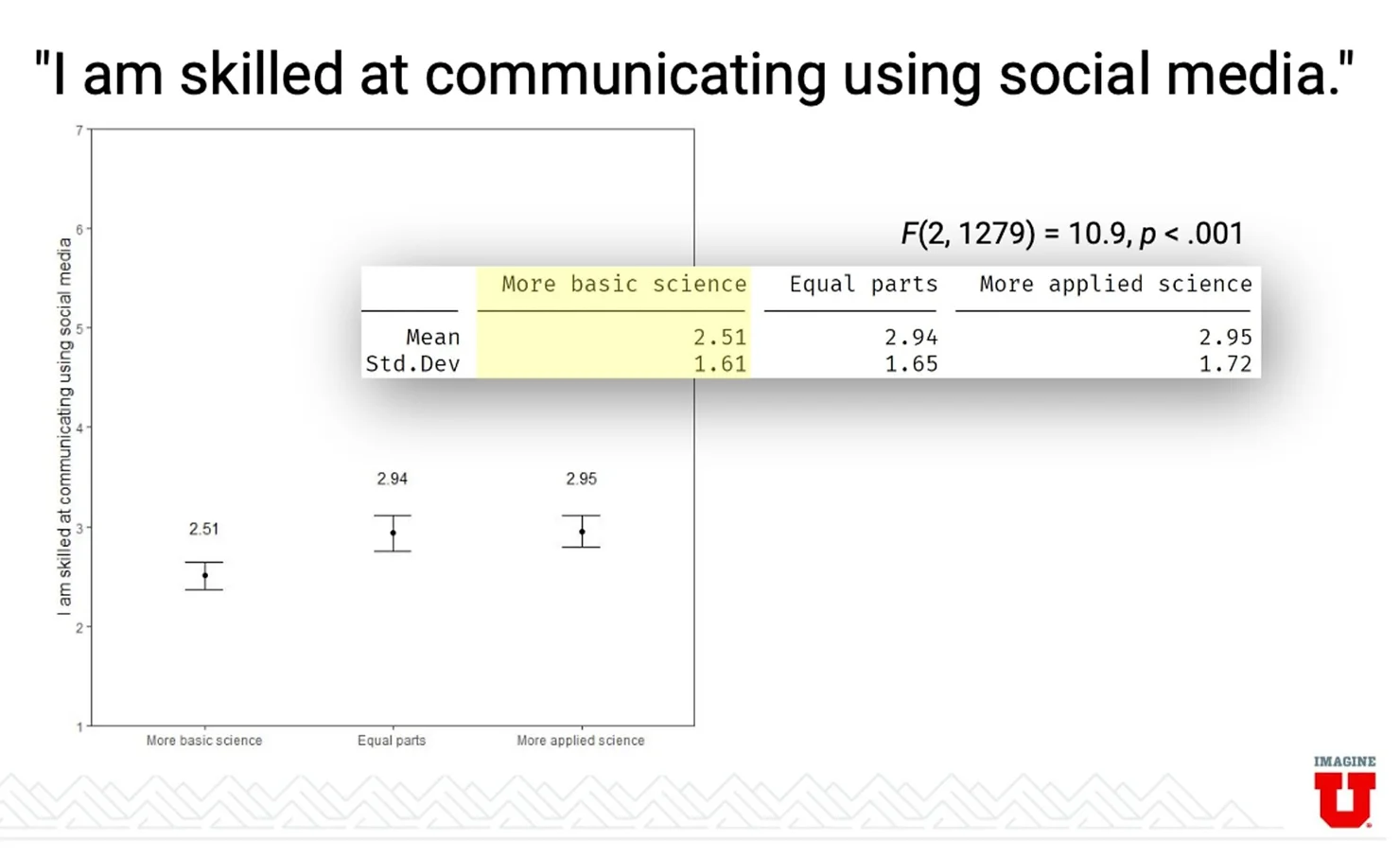
| The takeaways here are:Scientists across various research specialties generally accept the idea that social media can be used to communicate science.Compared to other researchers, basic scientists do not perceive social media to be as effective of a tool to communicate about science. Compared to other researchers, basic scientists do not think they are as skilled at communicating using social media |
Science communication views of (basic) scientists at AAU-affiliated universities
Continuing the exploration of scientist perceptions towards public engagement with basic science, Todd Newman, Assistant Professor in the Department of Life Sciences Communication at the University of Wisconsin-Madison, presented a survey study from 2021 that looked at scientists’ goals and objectives.
Inspired by SciPEP, Newman and his team asked scientists about the extent to which they consider their work more basic or more applied and used the responses to create five conceptual groupings:
- High basic, low applied (HBLA);
- High basic, medium applied (HBMA);
- High basic, high applied (HBHA);
- Medium basic, high applied (MBHA); and
- Low basic, high applied (LBHA).
Similar to the results seen by Sara Yeo and her team, a greater number of scientists selected “high basic, high applied” (44%) and “high basic, low applied” (22%) categories than the other groupings. This categorization allowed Newman and colleagues to see how scientists in certain disciplines categorize their research. For example, scientists in engineering fields mostly fell within the “high applied” categories, whereas scientists in physics and astronomy mostly fell within the “high basic” categories (Figure 6a).
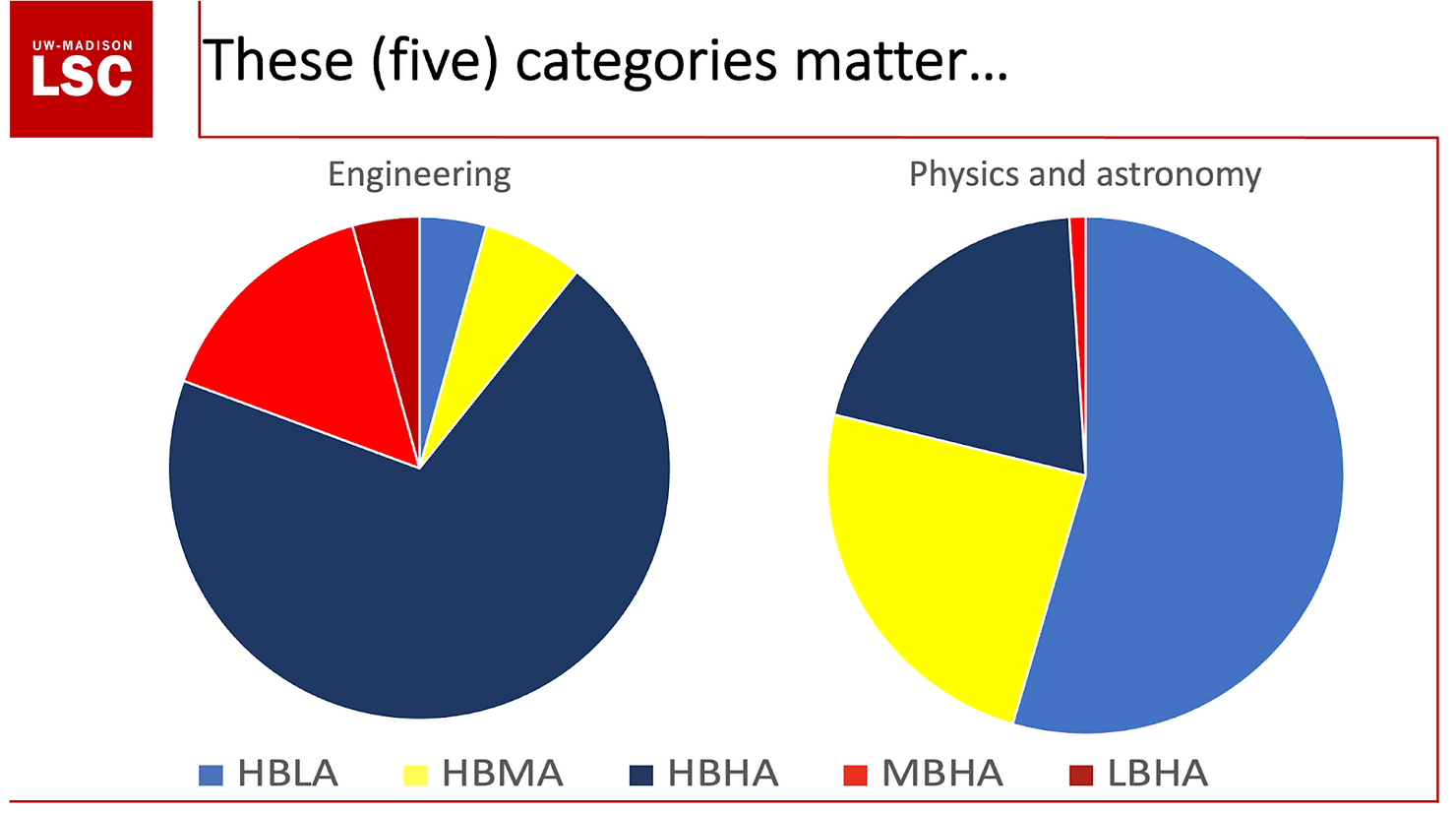
Looking at goal prioritization across the different categories, mostly basic scientists (HBLA category) prioritized emotional engagement goals, such as getting more young people to choose science careers. On the other hand, applied scientists prioritized practical engagement goals, such as ensuring that policymakers use scientific evidence and helping people use science to make better personal decisions.
Basic scientists also prioritized emotionally related objectives, such as getting people interested or excited about science and showing that the scientific community cares about society’s well being. Applied scientists, on the other hand, prioritized other objectives, such as hearing what others think about scientific issues and showing the scientific community’s expertise or ability to solve problems.
Based on Newman’s work, basic scientists aim to get young people to choose scientific careers and generate interest and excitement about science. They are less likely, however, to seek engagement that focuses on hearing what others think about scientific issues and ensuring that scientists ask questions that benefit society (Figure 6b). These results seem to align with Volpe’s process-minded (joy) vs. payoff-minded (hope for future outcome) categories.

| The takeaways here are:Scientists across different fields characterize their research as a mix of basic and applied at different degrees. For example, scientists in engineering fields mostly characterize their work as “highly applied,” whereas scientists in physics and astronomy mostly characterize their work as “highly basic.”Basic scientists prioritize emotional goals and objectives– such as influencing youth to seek scientific careers and generating interest and excitement about science. |
Science communication views of (basic) scientists from a census of research publication authors
John Besley, Ellis N. Brandt Professor of Public Relations at Michigan State University, presented about whether basic scientists have priority communication audiences and goals. Besley and Anthony Dudo (Associate Professor of Advertising and Public Relations at the University of Texas at Austin) conducted a census of the authors of research publications in top disciplinary journals of six basic science disciplines: Astrophysics, Atmospheric Sciences, Chemists, Nanoscience, Neuroscience, and Particle Physics.
Besley and Dudo asked scientists to identify their priority audiences for science communication. On the list of audiences were: youth groups, internal leadership, policymakers, media, the broader public, professionals, racial/cultural groups, private sector groups, and values-based groups. The team found that, for many scientists, the priority audience is typically their internal leadership. Notably, all audiences were considered important, with no statistically significant distinctions by discipline. However, Besley noted that there were some trends that might be worth further exploration. For example, astrophysicists seem to prioritize youth more highly, whereas atmospheric scientists lean more toward policy audiences. The least prioritized audience, however, is one that Besley believes we need to think more about engaging: values-based groups (such as conservatives and religious groups).
Next, Besley discussed findings about scientists’ priority goals and objectives. He explained the distinction between goals, which target behaviors (such as affecting health choices or acceptance of certain decisions), and objectives, which are cognitive and affective in nature (beliefs, feelings, and frames such as impacting self-efficacy or fostering feelings of hope).
Focusing mainly on the type of behavioral goals (such as affecting choices or acceptance of certain decisions) set by basic scientists, Besley’s team found that the average across “basic science” disciplines goals tend to be ranked high (5 or higher on a 7-point scale). Additionally, basic scientists by and large selected all the goals that they were presented with as potentially important (Figure 7). Besley concluded that scientists in general, whether basic or applied, want to do more than foster hope. They want to affect the world.
When Besley and colleagues compared their results to previous research on scientists’ goals,they did not find basic scientists’ goals to be distinct from those of applied scientists. However, they noted that basic scientists tend to prioritize goals that are more general and less specific.
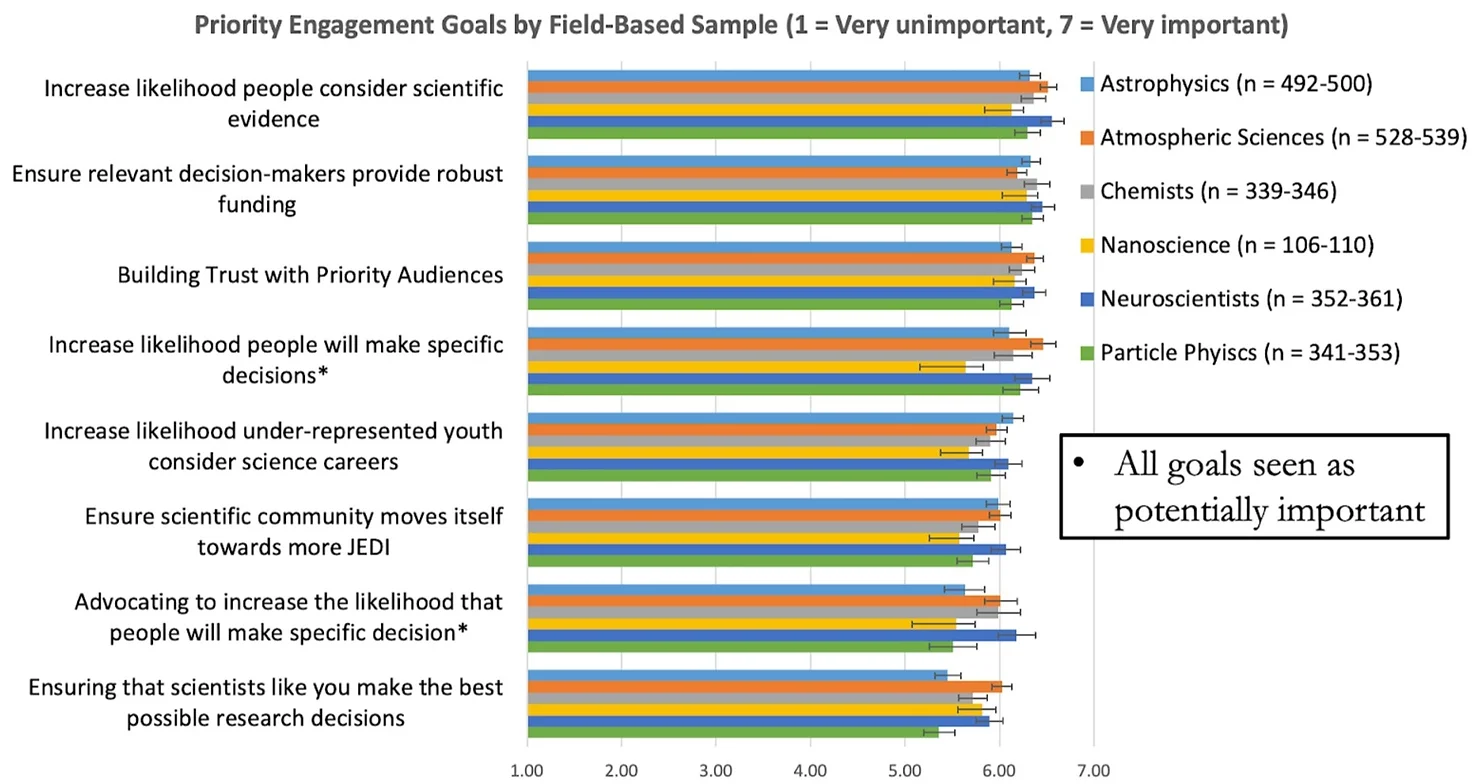
| The takeaways here are:All audiences are considered important to basic scientists, although internal audiences appear to be the highest priority and values-based groups appear to be the lowest. Scientists, generally, want to do more than foster hope. They want to actually make a difference in the world. Basic and applied scientists tend to perceive all communication goals as important, but basic scientists seem to prioritize more general than specific goals. |
In their discussion, the panelists highlighted how the identities of basic scientists may work in favor of public engagement with science. Chris Volpe re-emphasized that Americans judge the value of science by what it produces (the payoff) and not by the scientist’s qualifications or methods (the process). So, “good science” for the public is judged by the intended outcome and whether they agree with it.
The panel emphasized, however, that the distinction between process- and payoff-minded scientists should not mean preference for one mindset over the other. Both mindsets have strengths and weaknesses based on who the scientist is targeting and what their communication goal is. For instance, while a payoff-minded scientist may more easily contextualize their work to audiences, a process-minded scientist may be more enthusiastic and thus connect better with audiences.
So, how do we use this information? Besley underlined the importance of identifying mechanisms to help scientists evaluate their resources, goals, and access to audiences. These mechanisms could help scientists better shape their approach to communication. The questions are: How do we make scientists more strategic? How do we induce this behavioral change in scientists?
In this light, Newman called for more qualitative research with audiences from different communities to better understand the public’s emotions toward science. Additionally, Yeo warned that research still shows that we keep coming back to the same deficit model goals, which means there is a lot of work that still needs to be done to shift our approaches to science communication and engagement.
The Big Takeaway
Day 1’s questions explored ways by which basic science communication may be similar to or different from that of applied science. Science communication researchers and experts shared their ongoing work on: 1) public identities and views of basic science and 2) basic scientists’ identities and views of science communication. Our next summary is from the last session of Day 1 and will include insights on how establishing relevance can help create more effective basic science communications between basic scientists and their publics.
Written by Niveen AbiGhannam
Edited by Kay McCallum, Jacqueline Goldstein, Keegan Sawyer, Lauren Budenholzer, and Brooke Smith
Cover image prepared by SciCommBites and SciPEP

